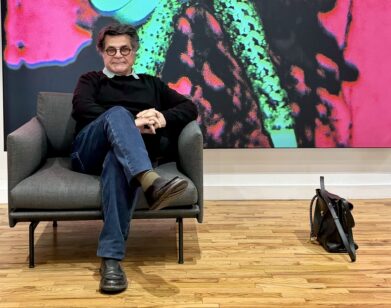Roxanne Assoulin
ROXANNE ASSOULIN IN NEW YORK, JANUARY 2017. MAKEUP: NARS SOFT MATTE COMPLETE CONCEALER IN CARAMEL.
With over 30 years of experience in jewelry design, Roxanne Assoulin’s career is a testament to the power of creative dynamism and personal reinvention. Her pieces are often vibrant in color yet minimalist in design, radiating confidence in both wearers and in her as a designer. As a contributor to labels like Ann Taylor, J. Crew, and Banana Republic, as well as the head of her own line, Assoulin certainly knows a thing or two about brand, aesthetic, and taking charge in an industry with tastes that change seemingly overnight. As a part of Interview x NARS Cosmetics’ “The Art of Throwing Shade,” Assoulin discusses her history as a designer, holding her own in business, and how dressing for success can just mean dressing for yourself.
STARTING OUT: I started a long time ago in 1983. I kind of fell into it back in the day—I sold stuff to Fiorucci, Bloomingdale’s, and Bendel’s way back when. I’ve gone through so many lives and metamorphoses, so I’ve been in this business for over 35 years. I tripped into it; I initially wanted to design clothing. I thought it would be beads and barrettes and I ended up making jewelry because it looked like instant gratification. There was no rhyme or reason, and sometimes I just don’t believe that there is any rhyme or reason to anything that we do.
ON SEXISM: There are two parts to doing business; one is the creative part, in which there was no problem with my gender as a woman. I don’t know that I feel “male” and “female” in the fashion world—I think it’s a little different. It’s more about me being intimidated by people knowing certain things that I didn’t know, but I don’t know if it boils down to gender rather than our basic insecurities and fears. I think men and women both have different strengths, and one of the things that women have is real common sense. In that financial world, it can be underestimated, or it could not be looked at because, “You don’t know the numbers.” And I’ll look at them and go, “Oh, well you don’t know what color blue to wear.” I don’t think one is better than the other—I just think it’s different.
FEELING EMPOWERED: I’ve been thinking about the difference between being a boss versus being bossy. A boss is a leader, but being bossy is detrimental; it’s a negative word, like, “She’s so bossy,” or something to that effect. I think that when we’re leaders—even if you’re leading a company or leading a family—there has to be a sense of humility that goes along with it. You’ve got to be humble. There is no bossy. For me, bossiness covers up insecurity. These words are just labels; they’re negative and shouldn’t be used for anyone. Gender shouldn’t come into it. It’s really just about people, about human beings. When we start to separate male/female, we get into trouble. I’ve learned to word it differently, even with my staff. It’s, “She’s a challenge to you. How do you deal with it?” That way, you’re the one being challenged—she’s not doing it.
In terms of empowerment, it’s the closer I am to my truth, to being sincere and authentic, the more I’m not hiding my insecurities but rather putting them on the table. How do I do that with people that I work for, with our buyers, our vendors—how do we be nice and live a life of integrity? That empowers me.
BEAUTY AND CONFIDENCE: I never, ever thought I was beautiful, so I always had to develop a style. I never thought I was pretty enough or beautiful enough. For me, I think I’m very much a uniform person; I’ve always been sneakers, jeans, and a sweater. I could even wear that at night—I just change the jeans for a skirt. After my divorce, one thing that I made a decision to do was to dress for myself and never dress for anyone else. I will go to a business meeting the same way that I’ll go to any meeting with anybody—I don’t change what I wear. I can go to the bank and I’m still wearing my jeans and sneakers. So I don’t power dress at all. Because I’m older, it might have been a big part of my life in the first part of my life. I would dress more to please people, and I would also be more like, “Who do you want me to be? Okay, I’ll be that.” And as you start getting older, you see that’s not working. You have all this stuff in your closet and you’re like, “Who bought that?” You start to get more comfortable in your own skin as you start to develop. When people wear my jewelry, I want them—when they get it and they wear it—to be happy. For that moment, I want them to see something that just makes them smile. That’s what it does for me; I put something on my wrist and I smile because I like the color. If I could give happiness to someone, just for a split second, that’s what I want to do.
FOR MORE FROM “THE ART OF THROWING SHADE,” CLICK HERE.







